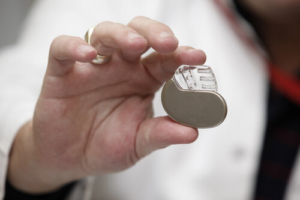Learn more about AFib and exercise. Should patients be exercising with a chronic heart condition?
For anyone living with atrial fibrillation, the idea of exercise can be a complicated topic. While we all know that regular exercise is a key to maintaining a healthy heart, it can be difficult to know what is safe and what can act as a trigger for an AFib attack.
Understanding How Exercise Impacts the Heart
When we exercise, the muscle cells in our body require a larger amount of oxygen than during times of rest. Because of this, our heart has to work harder to pump more blood at a faster rate around the body, causing an increase in our heart rate. While exercise is part of a healthy lifestyle, it is important to monitor the amount of exercise you are doing if you live with a chronic heart condition, such as AFib.
Is Exercise Safe for Someone with AFib?
Unfortunately, there is no easy answer to this question. It is important to do what feels right for your body, which will be different for every person.
When done correctly, daily exercise can be safe and incredibly therapeutic for people living with AFib. Daily exercise can help to strengthen the heart, maintain a healthy body weight, and reduce chronic stress. Using a heart monitor, such as a smart watch, during exercise can be a helpful tool for those wanting to keep an eye on their symptoms, but the most reliable indicator that you are doing too much is how you feel during and after your workout.
It is super important to understand when an exercise is too much for you. It is very dangerous to strenuously overdo exercise, as too much exercise may do more harm than good.
AFib and Exercise: The Exercises to Avoid
While exercise is great for your cardiac health, there are some exercises that I recommend people with atrial fibrillation should avoid, especially if you are being treated with blood thinners. These exercises include:
-
High-intensity workouts — If you are new to exercise, you do not want to overdo it. I highly recommend incorporating low intensity exercises like yoga, tai chi, and walking into your routine to prevent overexertion and heart stress. You can slowly build up in intensity as you build your fitness level.
-
Contact sports — If you are taking blood thinners, contact sports can be very dangerous. Avoiding sports like football, wrestling, and boxing is important to prevent your risk of injury and internal bleeding.
-
Extreme sports — Activities like mountain biking, snowboarding, and outdoor rock climbing elevate your risk of sustaining a serious injury. Ideally, these exercises should be avoided and replaced with lower risk options like indoor biking and harness rock climbing.
When to Stop Exercising — Understanding the Warning Signs
It is essential for patients who live with atrial fibrillation to understand how to identify a possible exercise-induced AFib attack. During periods of strenuous exercise (or mild exercise if you are already fatigued), you may develop an exercise-induced AFib attack.
Signs of an exercise-induced AFib episode include:
-
Heart palpitations
-
Feeling like your heart is racing
-
Low blood pressure
-
Feeling faint
-
Dizziness
-
Sweating
-
Anxiety
-
Shortness of breath
If any of these symptoms occur during your workout, you should stop immediately. Ideally, if you experience a mild episode, you can use at-home remedies such as vagal maneuvers and relaxation techniques to stop the attack. If you are unsuccessful in getting the episode to stop, you should seek urgent medical care.
For those using an at-home heart monitor during your exercise, you can also send the health information to your cardiologist to keep them in the loop about your symptoms. The more information they have, the better they will be able to tailor your care to your unique needs.
AFib and Exercise: Tracking Your Heart Rate During Exercise
One of the best ways to ensure that you don’t overexert yourself during an exercise is to monitor your heart rate with an at-home monitor. Exercise doesn’t need to be exhausting in order for you to reap the benefits — low intensity workouts that keep your heart at a healthy and sustainable heart rate are a great place to start.
Heart rate monitors like the Apple Watch or a Fitbit can be easily used to prevent your heart rate from escalating too high. Keeping your heart rate at the level of moderate exercise is one of the best ways to prevent exhaustion and the possibility of developing an AFib episode. To learn more about what moderate exercise looks like for you, be sure to consult with your primary care provider and cardiologist. They will be able to make recommendations for exercises and maximum heart rates depending on your exercise tolerance, medications, and AFib history.
AFib and Exercise: Recommendations for Patients with AFib
Overall, if properly managed, regular exercise is a great way to maintain your cardiovascular health while living with a chronic heart condition. If you are new to exercise and aren’t sure where to start, here are my recommendations:
-
Talk to your provider — Whether you’re new to exercise or have been working out for years, if you have been diagnosed with atrial fibrillation, you need to talk to your doctor about what exercises are safe and right for you. Your cardiologist can suggest low and high impact exercises that are safe for you, and will be able to better monitor your health as part of your team.
-
Start slow — If you are new to exercise, starting slow is key. Low impact exercises like walking, yoga, biking, swimming, and even physical chores around the house are a great place to start. Short durations of 5 – 10 minutes can even be enough to build heart strength and improve your cardiovascular endurance. Start slow, and build up to more strenuous and longer periods of exercise.
-
Try resistance training — As you become more comfortable with regular exercise, resistance training can be a great way to improve your health. Using light weight to start, resistance training can be done from home or at the gym. Be sure to start slow and with weights that are right for your body to prevent overexertion.
-
Wear a heart monitor — If you have one available, using a heart monitor, such as a smart watch, during exercise can be very valuable. Information about your heart rate and rhythm can be shared with your cardiologist to better adjust your treatment plan based on your heart health.
How To Reverse Atrial Fibrillation Naturally
If you are interested in natural treatment options for atrial fibrillation and are highly motivated in improving your symptoms naturally, to reduce your need for medications or even procedures, then take a look at my one-of-a-kind, online educational program, Take Control Over AFib.
Lifestyle modifications and reducing inflammation are essential components of the long-term management of atrial fibrillation. Addressing the source cause of atrial fibrillation can lead to a significant benefit for most AFib patients. Targeted lifestyle modifications can reduce your symptoms, reduce your reliance on medications or procedures, and even improve the long-term success rate of a catheter ablation procedure for AFib. However, most patients are not given instructions or tips on how to accomplish these essential lifestyle modifications in an AFib targeted style.
This is exactly why I created the Take Control Over AFib Program, to give people a step-by-step plan to improve and potentially reverse atrial fibrillation naturally.
Thinking about lifestyle modifications is easy, but putting in place a system to keep you committed to achieve real results takes time and dedication, and with my step-by-step plan, we can achieve powerful and long-lasting results together.
Putting It All Together
So, should you be exercising even if you have AFib? In most cases, the answer is yes. Regular exercise is essential for living a healthy and balanced lifestyle, just as long as you’re safe and understand your boundaries. Regular exercise can also be essential for weight loss, which is a valuable long-term treatment option for AFib. Overexertion can be dangerous for your heart and may lead to an AFib episode and the need for medical attention in severe cases.
I hope this article is a helpful resource for anyone trying to get back into regular exercise while living with a chronic heart condition. Be sure to talk to your provider before you start, and then get out there and try something new!
The Best Atrial Fibrillation Book
Your Complete Guide To AFib: The Essential Manual For Every Patient With Atrial Fibrillation

Shop AFib Products on Amazon
KardiaMobile 6-Lead Personal EKG Monitor – Six Views of The Heart – Detects AFib and Irregular Arrhythmias – Instant Results in 30 Seconds – Works with Most Smartphones - FSA/HSA Eligible

KardiaMobile 1-Lead Personal EKG Monitor – Record EKGs at Home – Detects AFib and Irregular Arrhythmias – Instant Results in 30 Seconds – Easy to Use – Works with Most Smartphones - FSA/HSA Eligible

Apple Watch Series 9 [GPS 41mm] Smartwatch with Storm Blue Aluminum Case with Silver Sport Band M/L. Fitness Tracker, Blood Oxygen & ECG Apps, Always-On Retina Display

Fitbit Sense 2 Advanced Health and Fitness Smartwatch with Tools to Manage Stress and Sleep, ECG App, SpO2, 24/7 Heart Rate and GPS, Shadow Grey/Graphite, One Size (S & L Bands Included)

OMRON - Complete Wireless Upper Arm Blood Pressure Monitor + EKG - Built-in Bluetooth Technology
35% Off
Omron Hem 7361T Bluetooth Digital Blood Pressure Monitor with Afib Indicator and 360° Accuracy Intelliwrap Cuff for Most Accurate Measurements (White)

EMAY Portable ECG Monitor | Record ECG and Heart Rate Anytime Anywhere | Stand-Alone Device with LCD Screen and Storage | No Subscription Required

SAMSUNG Galaxy Watch 6 44mm Bluetooth Smartwatch, Fitness Tracker, Personalized HR Zones, Advanced Sleep Coaching, Heart Monitor, BIA Sensor, Health Wellness Insights, Big Screen, US Version, Graphite

Natural Rhythm Triple Calm Magnesium 150 mg - 120 Capsules – Magnesium Complex Compound Supplement with Magnesium Glycinate, Malate, and Taurate. Calming Blend for Promoting Rest and Relaxation.

Pure Encapsulations Magnesium (Glycinate) - Supplement to Support Stress Relief, Sleep, Heart Health, Nerves, Muscles, and Metabolism* - with Magnesium Glycinate - 180 Capsules


















![Apple Watch Series 9 [GPS 41mm] Smartwatch with Storm Blue Aluminum Case with Silver Sport Band M/L. Fitness Tracker, Blood Oxygen & ECG Apps, Always-On Retina Display #1](https://m.media-amazon.com/images/I/311xwtp4mFL._SL100_.jpg)
![Apple Watch Series 9 [GPS 41mm] Smartwatch with Storm Blue Aluminum Case with Silver Sport Band M/L. Fitness Tracker, Blood Oxygen & ECG Apps, Always-On Retina Display #2](https://m.media-amazon.com/images/I/41j+8AaUGsL._SL100_.jpg)
![Apple Watch Series 9 [GPS 41mm] Smartwatch with Storm Blue Aluminum Case with Silver Sport Band M/L. Fitness Tracker, Blood Oxygen & ECG Apps, Always-On Retina Display #3](https://m.media-amazon.com/images/I/41jIyxZitnL._SL100_.jpg)
![Apple Watch Series 9 [GPS 41mm] Smartwatch with Storm Blue Aluminum Case with Silver Sport Band M/L. Fitness Tracker, Blood Oxygen & ECG Apps, Always-On Retina Display #4](https://m.media-amazon.com/images/I/41IpNJERjCL._SL100_.jpg)
![Apple Watch Series 9 [GPS 41mm] Smartwatch with Storm Blue Aluminum Case with Silver Sport Band M/L. Fitness Tracker, Blood Oxygen & ECG Apps, Always-On Retina Display #5](https://m.media-amazon.com/images/I/31o17yhfYpL._SL100_.jpg)

















































